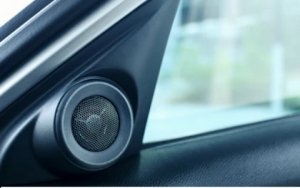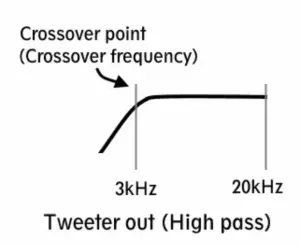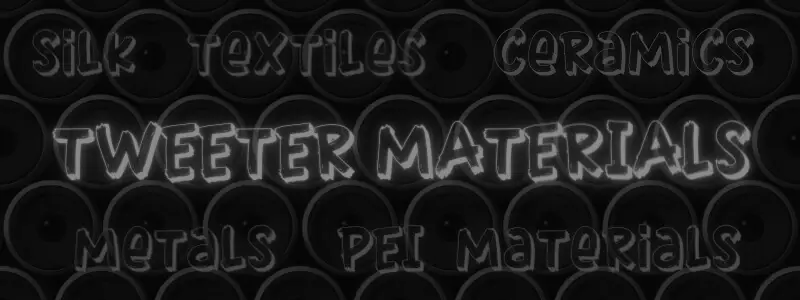What Are Tweeters and What Do They Do?
What are tweeters and what do they do for a car stereo system? For anyone new to car audio all the different parts and terminology can be confusing, so this article will equip any beginner with the necessary knowledge to be confident in understanding what tweeters are.
As with all car audio equipment, there’s no out-and-out best tweeters, because it really is down to personal preference. Different materials suit different sounds, and different shaped tweeters also produce different sounds, so it’s important to understand the nuances before you buy the ideal tweeters for your liking.
This article takes a deep dive and explains what tweeters actually are. Looking at how different materials affect sound reproduction, and then once you’ve read it, you’ll be more informed about what type of tweeters suit you.
What Are Tweeters And What Do They Do?
So, what are tweeters? Actually, they are speakers and are constructed like other speaker types, just smaller. Among other things, they consist of a small magnet, voice coil, a speaker dome of differing shapes and angled differently from other speakers.
They’re small speakers that produce the high frequencies (treble) you hear in music. They usually protrude from the middle of a coaxial speaker’s woofer cone. Or with components speakers, tweeters are completely separate drivers and come with separate crossovers.
Tweeters complement other speakers (woofers and subwoofers) that aren’t suited for producing high frequencies. As part of a full car stereo system, they make the high notes from vocals, guitars, keyboards, cymbals and other high-pitched instruments much more discernible.
Because higher sound frequencies produce smaller soundwaves, tweeters are smaller than other drivers. Think about it, the lower the frequency, the bigger the cone area needed, and that’s why subwoofers are generally the biggest drivers.
The frequency range that suits tweeters is roughly from about 3.5 kHz – 20k Hz, although some, known as super tweeters, can produce higher frequencies.
>>Take a look at the Best Tweeters on the Market<<
Why Are Tweeters Important For Car Stereo Systems?

As stated above, tweeters produce higher frequencies, and without them, the fidelity your sound system produces will be much more limited.
Music and sound are made up of more than low to high sounds. The sounds are a complex blend of tones and frequencies that need to be driven to the correct sized speaker to sound their clearest.
And in each speaker, the tweeter will work only to produce the high frequencies that woofers and subwoofers cannot produce. This not only ensures you get better treble but also the other speakers are freer to work on the ranges they’re designed, so the overall sound quality will be better.
Tweeters are never used alone, and are always part of a component speaker set or built into a 2-way coaxial speaker. Any 3-, 4-, or 5-way speaker will likely have a super tweeter and these smaller tweeters lighten the load for the main tweeter, resulting in clearer highs.
Why Do Tweeters Need a Crossover?
Every speaker needs a crossover to drive the frequencies to the correct driver. They can be inbuilt passive crossover, or an external crossover that comes with a component speaker set, but they all essentially do the same thing.
Crossovers push low frequencies to the subwoofer, low to mid frequencies to the main woofer, and of course high frequencies will be partitioned by the crossover and sent directly to the tweeter.
Without a crossover all frequencies would be directed to all speakers and the distortion would be unbearable, and damaging to the speakers.
A tweeter cannot play low frequencies and depending on the brand, it will only produce frequencies from about 3.5k Hz – 5k Hz and upwards.

Crossovers have filters to separate the frequencies, and the filter for the tweeter is known as the High Pass Filter (HPF), and like the other filters the HPF has a slope and cut off frequency.
The High Pass Filters will slope and meet at the Crossover Frequency between the high and band frequencies. The ideal crossover point -3dB of attenuation from each filter, and depending on how steep the slope is will determine the absolute cut off for that frequency in the tweeter.
There are two types of crossovers. I won’t go into too much detail as you can find out more about crossovers here, but basically, passive crossovers are easier to run but are more limited, whereas active crossovers are more complex, more expensive, but give you more options to sculpt the soundstage you desire.
Specifications To Look For In Tweeters
Tweeter Impedance
Like all speakers, tweeters have an impedance rating, and it’s important to know about it before buying a set. Impedance, rated in Ohms (Ω) and it basically describes the total electrical resistance to current for any speaker. So anything with less ohms will electricity to pass through it easier.
It’s important to know because crossovers are designed for the impedance rating of your tweeters. Also, unless you really know what you’re doing you should match your tweeters with the same impedance as your woofers, because it could affect the sound reproduction resulting in a mismatched soundstage.
You can use woofers and tweeters with different impedance, but it can be tricky to set up. The impedance your tweeters use at high frequencies will be low, but as long as you set the filters to the drivers correctly it can be done so the sound isn’t mismatched. Personally, I wouldn’t recommend it, because it’s easy enough to match everything.
Car speakers are usually rated at 4-ohms or 8-ohms, and making sure your amplifier can handle your speakers’ impedance is important. If you buy a set of component car speakers the impedance will be matching on all speaker components, so there will be no issue there, but again: make sure you get the right impedance for your amplifier.
Tweeter Power Rating
Because tweeters are made up of smaller parts they are more fragile and therefore won’t need as much power as bigger drivers. The average tweeters have a continuous power handling rating of 25w and 50w RMS, but they don’t need to move as much air or heat as bigger drivers, so more power handling isn’t necessary.
Wired into a sound system, they won’t use the same amount of power as bigger woofers, but as with everything in car audio there’s no exact setting. It depends on your crossover frequency setting and the music’s power spectral density, among other things, but typically for a tweeter that is crossed over at 3kHz your tweeter will get about 10% of the power that the woofer will get.
Remember to always make sure your amp can handle the extra load. If you’re adding tweeters it’s more power for your amplifier to handle, so a general rule of thumb is to make sure the power handling of your car amplifier is 50% more than the RMS of your entire speaker set up.
Tweeter Sensitivity (SPL Rating)
Just like other types of speakers, tweeters have a sensitivity rating. This is rated in decibels (dB) and it’s normally listed as the SPL (Sound Pressure Level) rating.
As with other drivers, the higher the sensitivity, the better for tweeters. Generally, anything above 89dB is considered very good, but don’t be put off any with lower sensitivity as they can sound just as good, but will likely need a bit more amplification to get the same soundstage.
Tweeter Material
The material used will affect the sound quality and durability of the tweeter, and there are many different materials used. Here are some of the most common materials.
Silk and Textiles
Softer materials such as silk and textile blends are known to produce a softer and more refined sound. They are often reinforced with other synthetic materials to add stiffness and improve damping, which allows you to ramp them up without losing the smoothness these tweeters are well known for.
Silk and other textiles are generally good for those who don’t blast out their music, and are the most common choice for most audiophiles.

PEI Materials
PEI materials can also be used to make tweeters. They’re made of different plastics and are known for being lightweight and produce brighter (crisp) tones than silk and other cloth materials. Other advantages for PEI materials is that they tend to use less power than other materials, and they’re resistant to humidity, which is important in a car interior.
The main downside to PEI materials is that they’re not particularly stiff and have poor damping qualities, which results in lesser accurate musical reproduction.
Metals and Ceramics
Some tweeters are made from harder materials such as ceramics, graphite, and even metal. The sound with these tweeters is often stronger and brighter than softer materials. They’re also known for being more durable than softer materials, but this doesn’t mean they’re better than others. Remember it’s all about personal taste.
Aluminium is a popular choice as it is light and strong enough to produce a bright and clear sound at higher frequencies. Titanium is another metal used, as it’s lighter and less resonant, and can reproduce fidelity as accurate as any other material.
Metal and ceramic speakers are an especially good choice if you are dealing with a lot of background road noise, such as driving with your windows down.
Tweeters Shape
The shape of your tweeter will also affect the distribution of high frequencies around your vehicle. The most common shapes are cone, dome and semi-dome, and focal tweeters.
Cone Tweeters
The most common shape are the cone tweeters. These are very affordable, mass produced and can be found in the cheaper tweeters, especially in factory tweeters. They don’t distribute the high frequencies widely, and aren’t known for reproducing music as accurately as other shapes.
Semi-Dome Tweeters
Semi-dome tweeters feature a small dome inside a shallow cone and the materials used are generally softer and less rigid. They tend to be used in coaxial speakers rather than as separate tweeters or component speakers, and are another relatively cheap option.
Dome Tweeters
Dome tweeters are an upgrade version of the semi-dome tweeters thanks to their improved sound dispersion. Higher-frequency sound waves are directional, and thanks to the dome shape the wider dispersion from dome tweeters offer a much better sound quality. The main downside to these tweeters is that they tend to need more power, and are more expensive.
Focal Tweeters
Focal tweeters aren’t as common as the other shapes, but thanks to the design the sound reproduction is better than cone and semi-dome tweeters.
The design is an inverted dome design. This means, unlike other shapes, the dome doesn’t protrude from the voice coil. Instead, it sits upside down, like a crater in the center. This results in a better sound radiation pattern, while providing a higher level of control for the listener.
Conclusion: Tweeters – The High Frequency Driver
Now you have an understanding of the basics and know what tweeters are. Like everything in audio they can be complex, so if you’re learning the basics and just getting going, I’d recommend a set of coaxial speakers with an inbuilt tweeter.
If you want a more pronounced sound and you feel confident enough to install a set of component speakers, the specifications of woofers and tweeters in a component set will be matched already. If you’re just getting some separate tweeters, it takes a it more knowledge, but with some due diligence, you shouldn’t have a problem.
Whichever drivers you have in mind, remember not to get all caught up in the specs. The power handling, impedance etcetera are important, but the tweeter design, shape and material is more important.
So, make sure you know how you like your high frequency reproduction, and match your taste to the material and shape of your tweeter more than any other spec.
Tweeters FAQs
Do I really need tweeters?
If you don’t have some in your car stereo system, they will make a big difference, because they allow you to pick up the highs that get drowned out by the mids and lows.
Which type of tweeter is the best?
There’s no out and out best tweeter. It’s all about personal taste, because of the sound each shape and material will produce. If you have a full aftermarket car stereo system, it’s probably a good idea to get some tweeters with a high sensitivity, but other than that, it’s down to personal taste.
Why are tweeters small?
Tweeters are smaller than other drivers because they make the highest frequency sounds, which uses less air to produce. A higher-frequency wave has more energy than a lower-frequency wave with the same amplitude, so the diaphragm has to vibrate faster, and bigger speakers can’t move that fast.
Are bigger tweeters better than smaller ones?
Bigger tweeters are more flexible and can be paired with midrange speakers easier, but the smaller the tweeter the better they sound the higher the frequency you belt out. Super tweeters are made especially for this.
What are super tweeters?
Super tweeters are usually smaller tweeters that drive higher frequencies than standard tweeters. They’re generally found in 3-way or 4-way speakers, which usually boast both a tweeter and super tweeter. The benefits of a super tweeter allows the speaker to separate the different sonic frequencies further, meaning you should get a more accurate sound quality.
Can I connect tweeters to door speakers?
If your door panel has an existing speaker grille in place, this will be a good location for your tweeter. But many people prefer to install tweeters higher up, or at least a good distance away from the woofers, as it makes your music sound more dimensional.
Do you need a crossover to run tweeters?
Every audio system needs a crossover to direct sound to the correct driver. Without a crossover it can cause too much frequency overlap between drivers which will likely increase distortion, degrade overall sound quality and likely damage your tweeters.

I am a passionate and skilled car audio enthusiast with 15 years of experience in the industry. My journey started when I replaced my first set of factory car speakers, sparking a deep love for high-quality sound. Since then, I have worked as a representative for renowned brands like Kenwood and Alpine.
With a background in both retail and distribution, I have developed a comprehensive understanding of the car audio market. Currently a certified (MECP) installer in the Mobile Electronics industry, my expertise lies in delivering top-notch audio installations. My knowledge, coupled with my genuine passion, makes me the go-to professional for all car audio needs.


